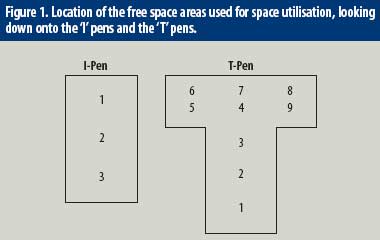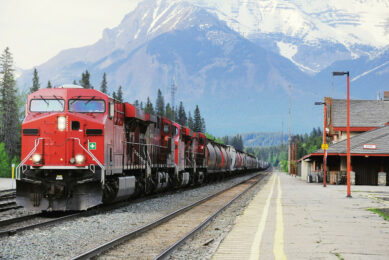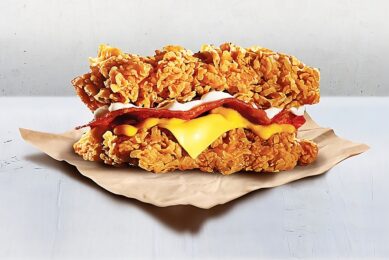Free space utilisation of sows in free access stalls

2013 marks the start of mandatory group housing for sows in the European Union. Group housing of sows, however, is being discussed and researched in other parts of the world as well. The Prairie Swine Centre recently investigated free access stalls and found that not all sows used the free space areas on a regular basis, or for extended periods of time.
By Harold Gonyou, Fiona Lang, S.M. Hayne and V. Heron, Prairie Swine Centre, Saskatoon, SK, Canada
With announcements by the largest producer/ packers in both the USA and Canada that they will transition all of their production facilities to group housing for sows over the next ten years, all North American producers are anticipating a change to group housing. This can be a challenging step for producers, and it is made more difficult by the lack of scientific information currently available on the implementation and design of alternative systems.
Group housing systems can be complex to initiate and require greater input from stockmen, however when done correctly, can produce sows that are able to socially interact with one another and have the freedom to move. Sows currently housed in gestation stalls have almost no opportunity to exercise and perform natural behaviours, leading to a possible decline in well-being.It has previously been suggested that exercise is required to maintain bone composition and strength, and when exercise is insufficient, calcium will be mobilised from the bone itself. Exercise is important to allow the development of bone and muscle to their maximum potential.Decreased muscular strength (which is commonly observed in confined sows) can contribute towards difficulty in lying and standing, and higher susceptibility to lameness due to increased slipping. Lack of exercise in confined housing has also been shown to cause bone weakness in other species. For example, confined laying hens have significantly weaker humeri and tibiae than birds housed in non-restrictive environments.
Free access stalls
One possible alternative to gestation crates are free access or walk-in/ lock-in stalls. This system provides sows with opportunities to interact as a group in a communal area, or remain alone in a free access stall. There is some concern regarding the degree to which sows use free space group areas, and how to avoid aggression, particularly when new sows are mixed into a group.
A recent study at the Prairie Swine Centre investigated the implementation of walk-in/ lock-in stalls for group housed sows. More specifically, the objectives of this study were to compare two different pen configurations by determining the proportion and type (size/ parity) of sows that are using the free space areas of the walk-in/ lock-in stalls, and also how sows utilise the free space areas.
Experimental procedures
Eight groups of approximately 25 sows were used in the study, and were housed in walk-in/ lock-in stall gestation pens at the Prairie Swine Centre, Saskatoon, Saskatchewan, Canada. Groups were selected according to how many individuals were confirmed pregnant in a batch of animals within a two-week breeding date window, therefore group size was not always the same. Each of the groups were exposed to one of two configurations of free space areas.
- The first is referred to as the ‘I’ pen as it consisted of an alley (3 x 11 m) with slatted flooring running between two rows of 16 stalls on each side. Any additional stalls, surplus to the group number, were locked off for the purpose of the trial.
- The second pen configuration is referred to as the ‘T’ pen as it consisted of an identical alley with an additional solid floor loafing area at one end (3.6 x 7 m).
Sows were weighed when moved from their breeding stall to the gestation pen, and individually marked with livestock paint. Photographs were taken from mounted cameras at two minute intervals over a 24 hour period, once a week, for 11 weeks throughout gestation. Two cameras were set up in the ‘I’ pen, one at each end of the pen. Four cameras were used in the ‘T’ pen in order to also observe the free space area. The pens were divided into three areas (I pen) and nine areas (T pen) (see Figure 1). The individual sow and location was recorded numerically by a trained observer. Measurements recorded from the photographs include the percentage of time spent out of the stall over 24 hours, and also the location and position of sows in the free space areas.
Results and discussion
The majority of sows did use the free space areas (more than 95% of sows) although not on a regular basis or for extended periods of time. The average usage for the ‘I’ and ‘T’ pens were both relatively low, however, the sows housed in the ‘T’ pens used the free space area significantly more than the sows housed in the ‘I’ pens.
More than half the animals in the study spent less than 5% of their time in the free space area, however the average usage was ~18% (with considerable individual variation). Heavier sows appeared to use the free space area significantly more than lighter sows, and older (higher parity) sows also used the free space significantly more (Figure 2). Figures 3 and 4 illustrate the preferred lying areas of the sows. In the ‘I’ pens, the far end of the pens was the most preferred place to lie, with the highest recorded usage in Area 3 with 8.9% of the average total usage. Similarly, with the ‘T’ pens, the most preferred place to lie was also in the corners (Areas 5, 6, 8 and 9). Although many sows did use the free space, it was at a much lower level than expected. This could be due to several possibilities, such as lower ranking animals feeling threatened by higher ranking sows, or larger sows utilising the free space due to crowding in the stalls.
Body shape
It has been suggested that due to the rigorous selection for improved meat production, the body shape of modern domestic pigs has been changed. Selection has resulted in larger pigs which can have difficulty lying and standing, and may not fit comfortably into conventional stalls. All the areas where sows have shown a preference to lie down have more walls than the other available areas, which can act as support. This finding is in agreement with previous studies (mostly in the farrowing environment) where sows also show preference to use support when lying down. Marchant and others reported that 89% of lying down events were carried out using either a sloping wall, or a wall fitted with a piglet protection rail.
With the transition towards group sow housing it is important that scientific research is used to design the optimum housing system which can facilitate social interactions and minimise aggression and competition. Future research resulting from this study will focus on methods for encouraging the sows to utilise the free space areas.This will include improving the comfort of the free space area with rubber mats, providing environmental enrichment, or possibly allowing sows access to the free area in different social groups (alternate groups) i.e. gilts and sows.











